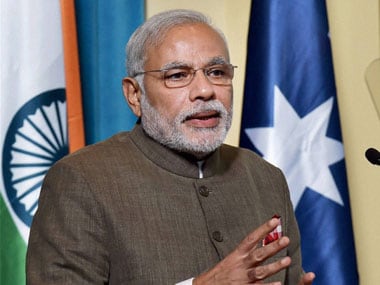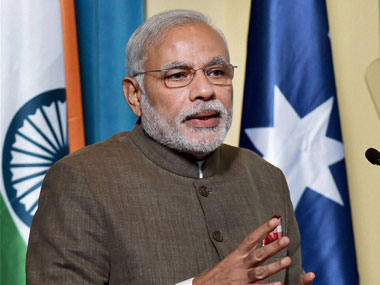By Rajesh Pandathil and Kishor Kadam Narendra Modi stormed to power giving hopes of a revival in the economy. He promised things will be different once he becomes the prime minister. There will be quick decision making, jobs will be created, farmers’ issues will be taken care of and the economy will start booming. It was a please-all election manifesto.[caption id=“attachment_2261180” align=“alignleft” width=“380”]  Prime Minister Narendra Modi. PTI[/caption] Reeling under a complacent UPA, the people were impressed with what Modi had to offer. But one year on, there is all-round disappointment. Everybody from farmers to foreign investors are pinning the government down on various issues. How far are they correct? Here’s a look at six data points that will explain the disillusionment that has pushed the government into the defensive mode. Inflation is one of the most closely watched indicators. Everything, from the RBI rate cut to growth revival, hinges on inflation. And the government is heaving a big sigh of relief on this count. A look at the WPI inflation, which gauges the prices at the wholesale level, should give a big relief to the government for it has been consistently falling. In fact, WPI has been in the negative for the last six months in a row. But then nobody is bothered about this figure anymore. The RBI looks at CPI inflation, or retail prices, when taking decisions on interest rates. Retail inflation, meanwhile, is falling too. From a high of 8.33 percent in May 2014, when Modi came to power, it has fallen to 4.87 percent in April 2015. It had fallen to 3.27 percent in November 2014. But should the government take all the credit for the fall in the prices? The answer is no. The fall in commodity prices is mostly linked to the benign global crude oil prices, which have declined about 50 percent in the last one year. Some of the supply side steps taken by the government with regards to managing food stocks have indeed helped. But there has not been any major reforms yet on this front. So, if the crude prices go up in the next few months, the comfort on this front is likely to vanish at least in part. A monsoon failure, which is highly likely given the looming El Nino, will only add to the pain. Next important data to look at is Index of Industrial Production (IIP). Here, the government has nothing much to cheer about. The index measures the factory output growth. In May 2014, industrial output had grown 5.6 percent on year. By March 2015, this growth fell sharply to 2.1 percent. So is the case with manufacturing IIP too. From 5.9 percent in May 2014, it has nosedived to 2.2 percent in March 2015. This is particularly bad for the economy because a revival is possible only if (and when) manufacturing output increases. Clearly, Modi’s one year rule has failed to make the a huge difference. The growth in the core sector, which includes eight sectors namely electricity, coal, cement, steel, petroleum refinery products, natural gas, fertilisers and crude oil, is another case in point. From 2.3 percent in May 2014, it has fallen to (-)0.1 percent. The magnitude of the fall reveals itself when you consider the high growth the sectors witnessed in June 2014 - 7.3 percent. One number that will help you pin point the real reason behind the wobbly revival is bank credit growth. Non-food credit growth of banks has fallen consistently - from 14.2 percent recorded in April 2014 to just 8.6 percent in March 2014. What this means is banks have not been lending. The main reason for this is the difficult situation they are in because of the high non-performing assets. Besides, private companies are not yet feeling confident enough to make fresh investments in projects. There is only one way out: the government should start investing. But that is not happening. Worse still, the government is actually cutting its spending as it is hell bent on meeting the ambitious fiscal deficit target. Another bright spot for the government seems to be the GDP growth. From 6.5 percent in April-June, it grew to 8.2 percent in the second quarter and 7.5 percent in the third quarter. The government has estimated the growth for the full year at 7.4 percent. But do we call this a bright spot yet? The high growth has come in because of a change in the way GDP is being calculated. There have been criticisms about this. All the aforementioned data points will tell you why the GDP growth figures should be taken with a pinch of salt. If indeed the growth so good, why is the bank credit not picking up? Why is factory output still languishing in the low 1-2 percent levels? Why is consumption demand not looking up despite a fall in inflation? This is not to say that everything is bad under Modi and spread pessimism about the economy. But the indicators do not offer any sign of revival happening in the economy yet. While given the sorry state of affairs in the economy, one shouldn’t have expected a sudden turnaround anyways. Nonetheless, the prime minister is paying a price for the great expectations he built up in the run-up to the elections. He presented himself as the one-man solution for all the ills of the economy. But the ground reality is that not everything is in his hands. For one, a turnaround in the domestic economy is also dependent on global factors. And, as he must have learnt the hard way by now, he cannot run the show on his own. He has to take into account not just his colleagues, but even the Opposition. The sooner he acknowledges this, the better.
Modi cannot run the show on his own. He has to take into account not just his colleagues, but even the Opposition.
Advertisement
End of Article
Written by FP Archives
see more


)

)
)
)
)
)
)
)
)



